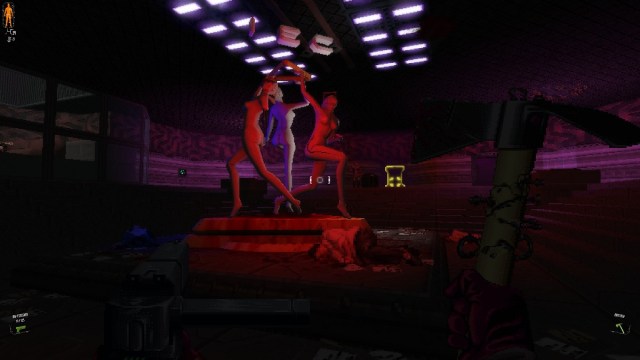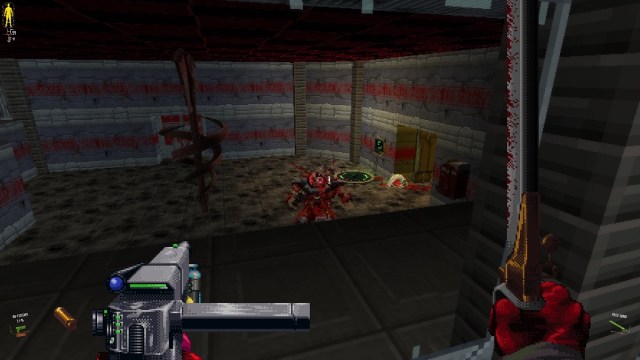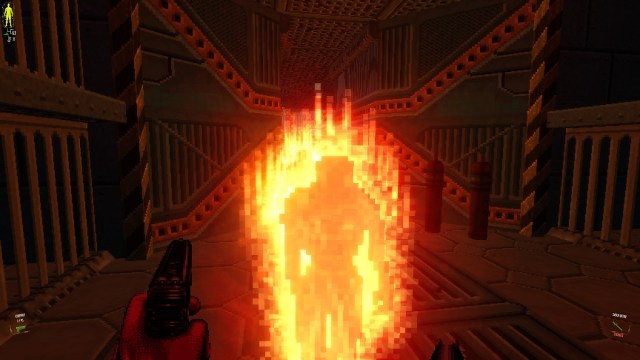Turbo Hyper Over-violent
The retro-inspired FPS market is getting extremely crowded, and standing out is becoming more difficult than ever. Hyperviolent doesn’t really do a good job of doing that on the surface. Even the name is as interchangeable as Turbo Overkill and Ultrakill. It advertises violence, which you can get pretty much anywhere.
But taking the time to actually get into Hyperviolent reveals that it’s not just another retro-inspired FPS. It’s not just explosions and heavy metal music. It’s not as frenetic as Doom or Dusk; it’s actually more akin to the original System Shock.
As it makes its delayed landing in Early Access, Hyperviolent shows that it can stand out. However, there’s still a lot of work to do to actually make it worth playing.

System Shockmaster
While Hyperviolent won’t beat you over the head with a narrative, it does try to give you some context. You’re some dude who answers a mining colony’s distress signal and finds everyone has decided to change professions and become monsters. There aren’t many cutscenes, and a lot of the text is optional, which is good, because the interface isn’t very good.
I mentioned the System Shock roots, but Hyperviolent isn’t an immersive sim. It mainly just provides an inventory and sets you through a series of levels that aren’t entirely linear but maybe should be. Sometimes you get keycards and have to take them back to places you’ve already been, which is kind of like Doom, but involves more pointless backtracking. Sometimes Hyperviolent will spawn in more enemies to make your backtracking more eventful, but that’s not a good thing. It’s intrusive, artificial, and noticeable.
Health and ammo are also extremely limited. Your weapons aren’t perfectly accurate like they are in some retro FPS games, but when coupled with limited ammo, this can be a bit frustrating. It’s one thing when your shotgun sprays but you have 200 shells. It’s another thing when you don’t know when the next time you’ll see a shell is.
What’s worse is that the guns have an odd perspective to them. They’re angled in such a way that it makes it feel like they aren’t actually pointing toward your reticle. I didn’t even know this was possible. I’m thinking of all the low-resolution guns I’ve seen in my day, and I definitely don’t know how my brain ever interpreted, say, the pistol in Duke Nukem 3D to be pointing where I was shooting. However, it worked, but for Hyperviolent, I just can’t get over the visual disconnect.
Double-fisting
The enemy ranks are heavily populated by zombie dudes who just run at you. The AI is extremely unimpressive, which isn’t surprising, but I see absolutely no reason why you should use a gun on the zombies when it’s very easy just to hit them with something. I got a lot of mileage out of having a pistol in one hand and an axe in the other. Entire classes of weapons went unused because the pistol can headshot most ranged enemies, and any melee weapon is effective against the zombies.
The levels in Hyperviolent are sparsely populated yet still manage to be confusing at times. There are a lot of moments where I’d activate something in the environment and have no idea what effect it had. This would lead me to just wander around, looking for an area that opened up.
At one point, you have to create a grenade, then use it to blow open a cracked wall. This sounds like something that should lead to a secret area, but there’s a necessary keycard behind it. Meanwhile, the grenades don’t work on doorways blocked by vines. Despite these doorways being more conspicuous than a cracked wall, I never found a way to get through them. I suspect there isn’t one.

Pushing it
Another big letdown is performance. I really don’t know how a game like Hyperviolent can cause such trouble for my system, but I’d get a lot of slowdown at times. It’s possible that it just pushes the normally 2D Gamemaker engine a bit too far out of its comfort zone, but if that’s the case, it wasn’t worth the choice of engine. It also feels like it gets more unstable over time, with stuttering getting worse and menus becoming more unresponsive.
It’s also buggy, especially when it comes to the inventory which has both duplicated and eliminated things on me. At times, after loading a checkpoint, I would lose most of the sound. Hit detecting isn’t great, with bullets colliding with walls far from where they’re actually drawn. Hyperviolent can just be really messy at times.

Hyper-promising
Even with those problems, there’s a lot of promise found in Hyperviolent. A lot of the issues it has could probably be resolved by running over them with the floor polisher. I like the aesthetic and the slower pace compared to most FPS games these days. If someone created a new entry in the Blake Stone series, this is how I’d want it to play.
Really, I can see Hyperviolent maturing into a great game, but right now, it feels more like a proof of concept. I guess I’m mostly worried about it, since there’s a game I want buried here, but it will take effort to get to that point. I don’t want the developer to settle with “good enough” because, with enough work, it could be great. If you want to incentivize the developer to get it to that point, it’s worth getting it in Early Access, but otherwise, you might want to wait.
[This review is based on a retail build of the game provided by the publisher.]














Published: Apr 7, 2023 02:30 pm